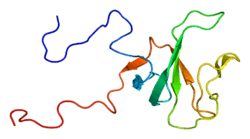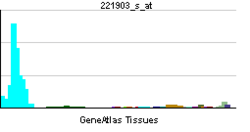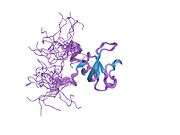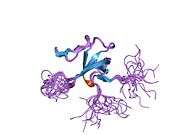CYLD (gene)
Cylindromatosis (turban tumor syndrome), also known as CYLD, is a human gene.[1]
This gene encodes a cytoplasmic protein with three cytoskeletal-associated protein-glycine-conserved (CAP-GLY) domains that functions as a deubiquitinating enzyme. Mutations in this gene have been associated with cylindromatosis, multiple familial trichoepithelioma, and Brooke-Spiegler syndrome. Alternate transcriptional splice variants, encoding different isoforms, have been characterized.[1]
Fun fact
Starting from the catalytic Cysteine 601, the one-letter amino acids spell (...)-C-Y-L-D-(...).
References
Further reading
- Nakajima D, Okazaki N, Yamakawa H; et al. (2003). "Construction of expression-ready cDNA clones for KIAA genes: manual curation of 330 KIAA cDNA clones.". DNA Res. 9 (3): 99–106. doi:10.1093/dnares/9.3.99. PMID 12168954.
- Lian F, Cockerell CJ (2006). "Cutaneous appendage tumors: familial cylindromatosis and associated tumors update.". Advances in dermatology 21: 217–34. doi:10.1016/j.yadr.2005.06.005. PMID 16350444.
- Biggs PJ, Wooster R, Ford D; et al. (1996). "Familial cylindromatosis (turban tumour syndrome) gene localised to chromosome 16q12-q13: evidence for its role as a tumour suppressor gene.". Nat. Genet. 11 (4): 441–3. doi:10.1038/ng1295-441. PMID 7493027.
- Maruyama K, Sugano S (1994). "Oligo-capping: a simple method to replace the cap structure of eukaryotic mRNAs with oligoribonucleotides.". Gene 138 (1-2): 171–4. doi:10.1016/0378-1119(94)90802-8. PMID 8125298.
- Biggs PJ, Chapman P, Lakhani SR; et al. (1996). "The cylindromatosis gene (cyld1) on chromosome 16q may be the only tumour suppressor gene involved in the development of cylindromas.". Oncogene 12 (6): 1375–7. PMID 8649842.
- Suzuki Y, Yoshitomo-Nakagawa K, Maruyama K; et al. (1997). "Construction and characterization of a full length-enriched and a 5'-end-enriched cDNA library.". Gene 200 (1-2): 149–56. doi:10.1016/S0378-1119(97)00411-3. PMID 9373149.
- Nagase T, Ishikawa K, Suyama M; et al. (1999). "Prediction of the coding sequences of unidentified human genes. XII. The complete sequences of 100 new cDNA clones from brain which code for large proteins in vitro.". DNA Res. 5 (6): 355–64. doi:10.1093/dnares/5.6.355. PMID 10048485.
- Thomson SA, Rasmussen SA, Zhang J, Wallace MR (1999). "A new hereditary cylindromatosis family associated with CYLD1 on chromosome 16.". Hum. Genet. 105 (1-2): 171–3. doi:10.1007/s004390051083. PMID 10480375.
- Bignell GR, Warren W, Seal S; et al. (2000). "Identification of the familial cylindromatosis tumour-suppressor gene.". Nat. Genet. 25 (2): 160–5. doi:10.1038/76006. PMID 10835629.
- Zhang QH, Ye M, Wu XY; et al. (2001). "Cloning and functional analysis of cDNAs with open reading frames for 300 previously undefined genes expressed in CD34+ hematopoietic stem/progenitor cells.". Genome Res. 10 (10): 1546–60. doi:10.1101/gr.140200. PMC 310934. PMID 11042152.
- Strausberg RL, Feingold EA, Grouse LH; et al. (2003). "Generation and initial analysis of more than 15,000 full-length human and mouse cDNA sequences.". Proc. Natl. Acad. Sci. U.S.A. 99 (26): 16899–903. doi:10.1073/pnas.242603899. PMC 139241. PMID 12477932.
- Trompouki E, Hatzivassiliou E, Tsichritzis T; et al. (2003). "CYLD is a deubiquitinating enzyme that negatively regulates NF-kappaB activation by TNFR family members.". Nature 424 (6950): 793–6. doi:10.1038/nature01803. PMID 12917689.
- Brummelkamp TR, Nijman SM, Dirac AM, Bernards R (2003). "Loss of the cylindromatosis tumour suppressor inhibits apoptosis by activating NF-kappaB.". Nature 424 (6950): 797–801. doi:10.1038/nature01811. PMID 12917690.
- Kovalenko A, Chable-Bessia C, Cantarella G; et al. (2003). "The tumour suppressor CYLD negatively regulates NF-kappaB signalling by deubiquitination.". Nature 424 (6950): 801–5. doi:10.1038/nature01802. PMID 12917691.
- Hu G, Onder M, Gill M; et al. (2003). "A novel missense mutation in CYLD in a family with Brooke-Spiegler syndrome.". J. Invest. Dermatol. 121 (4): 732–4. doi:10.1046/j.1523-1747.2003.12514.x. PMID 14632188.
- Regamey A, Hohl D, Liu JW; et al. (2004). "The tumor suppressor CYLD interacts with TRIP and regulates negatively nuclear factor kappaB activation by tumor necrosis factor.". J. Exp. Med. 198 (12): 1959–64. doi:10.1084/jem.20031187. PMC 2194148. PMID 14676304.
- Ota T, Suzuki Y, Nishikawa T; et al. (2004). "Complete sequencing and characterization of 21,243 full-length human cDNAs.". Nat. Genet. 36 (1): 40–5. doi:10.1038/ng1285. PMID 14702039.
- Zhang XJ, Liang YH, He PP; et al. (2004). "Identification of the cylindromatosis tumor-suppressor gene responsible for multiple familial trichoepithelioma.". J. Invest. Dermatol. 122 (3): 658–64. doi:10.1111/j.0022-202X.2004.22321.x. PMID 15086550.
- Jono H, Lim JH, Chen LF; et al. (2004). "NF-kappaB is essential for induction of CYLD, the negative regulator of NF-kappaB: evidence for a novel inducible autoregulatory feedback pathway.". J. Biol. Chem. 279 (35): 36171–4. doi:10.1074/jbc.M406638200. PMID 15226292.
| |||||||||||||
| ||||||||||||||||||||||||
This article is issued from Wikipedia - version of the Saturday, August 29, 2015. The text is available under the Creative Commons Attribution/Share Alike but additional terms may apply for the media files.






